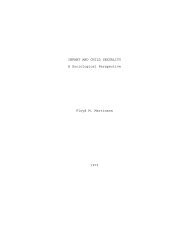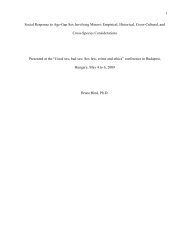Download PDF - Springer
Download PDF - Springer
Download PDF - Springer
You also want an ePaper? Increase the reach of your titles
YUMPU automatically turns print PDFs into web optimized ePapers that Google loves.
336 Ames and Houston<br />
question, either the males or the females of the species leave the home troop<br />
at sexual maturity, thus rendering incestuous matings unlikely. Female chimpanzees<br />
in estrus have been observed to display violent behavior to ward off<br />
the sexual advances of a brother (Goodall, 1971).<br />
Due to the widespread cross-species and cross-cultural nature of the<br />
incest taboo, sociobiologists contend that avoidance of incest has evolved<br />
as an adaptive pattern. Bischof (1975) contends that natural selection seems<br />
to favor behavior patterns that render incest very improbable. Breuer (1984)<br />
stated that "in the light of today's ethological knowledge it must be assumed<br />
that the notion of incest was not 'invented' at all, but rather that men inherited<br />
from their ancestors unconscious behavior patterns of inborn incest<br />
avoidance that later were woven into their culture."<br />
Whether the avoidance of incest is a biological or a sociological imperative,<br />
intrafamilial adult/child sex involves a second dimension of deviance<br />
over and above the societal prohibitions against the sexual use of children.<br />
If we assume that the practice of incest involves the breaking of two norms,<br />
we can expect to find lower rates of incest than rates of extrafamilial<br />
adult/child sex within the population. Evidence on the prevalence of sexual<br />
abuse reviewed below generally supports this statement.<br />
This hypothesis of double deviance serves to confound research into<br />
the etiology of incest. Natural questions that have arisen but are as yet unanswered<br />
concern the specificity of the incestuous father's arousal. Certainly,<br />
some pedophilies marry and have children (Abel et al., 1987). Instances of<br />
inappropriate sexual age preferences are found less frequently among incestuous<br />
fathers than among nonincestuous child molesters (Quinsey et al., 1979).<br />
If this finding remains constant under replication, somewhat different processes<br />
are involved in the etiology of incest and in the etiology of pedophilia.<br />
PREVALENCE OF ADULT/CHILD SEX<br />
Ascertaining a definitive estimate of the prevalence of adult/child sex<br />
is understandably difficult. Estimates derived from crime statistics involve<br />
only reported cases and are likely to be an underrepresentation. Retrospective<br />
reports carry their own inherent problems but are perhaps our best source<br />
of knowledge. Finkelhour (1979) questioned 530 female and 266 male college<br />
students about their sexual experiences in childhood. Results revealed that<br />
11070 of the females and 4°70 of the males reported having had an unwanted<br />
sexual experience with an adult before the age of 12. Females reported that<br />
46070 of such encounters involved a relative, 33070 an acquaintance, and 24o70<br />
a stranger. Males were less often abused by a relative (17o70) and more often<br />
by acquaintances (53°70) and strangers (30°7o).
















